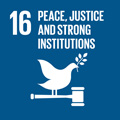- Docente: Lorenzo Zambernardi
- Credits: 8
- SSD: SPS/04
- Language: English
- Teaching Mode: Traditional lectures
- Campus: Forli
- Corso: Second cycle degree programme (LM) in International relations and diplomatic affairs (cod. 6058)
-
from Sep 24, 2024 to Dec 10, 2024
Learning outcomes
The course aims to achieve advanced knowledge of the main contemporary theories of international relations (realism, liberalism, constructivism). At the end of the course, students will command the most important debates within the IR literature. They will have also developed the analytical skills necessary to understand the functioning of the contemporary international system.
Course contents
The course examines the most important theories of international politics and foreign policy, with a particular focus on constructivism, liberalism, and realism. We will also study some key concepts of international relations such as the balance of power, hegemony, war, and cooperation.
Readings/Bibliography
1) Introduction
- No reading
2) International Relations Theory and Its Political Relevance
- Jack Snyder, 2004, “One World, Rival Theories,” Foreign Policy, Nov., 52-62
- Lorenzo Zambernardi, “Politics is too important to be left to political scientists,” European Journal of International Relations, 22(1), 2016, pp. 3-23.
3) Armed conflicts in the current world
Davies, S., Pettersson, T., & Öberg, M. (2023). Organized violence 1989–2022, and the return of conflict between states. Journal of Peace Research, 60(4), 691-708.
4) Classical realism I
- Thucydides, “The Melian Dialogue,” The Peloponnesian War, V, 84-114.
5) Classical realism II
- E.H. Carr, The Twenty Years' Crisis, ch. 2.
6) Classical realism II
- Hans J. Morgenthau, 1948, Politics Among Nations, Part two chapters. 1, 2, 3 (pp. 13-49).
7) Structural realism
- Kenneth N. Waltz, 1977, Theory of International Politics, chapters 4-5.
8) Balance of power
- Kenneth N. Waltz, 1977, Theory of International Politics, chap. 6
- Paul Schroeder, 1994, “Historical Reality vs. Neo-Realist Theory,” International Security, 19, 1, 108-148.
9) Hegemony
- Robert Gilpin, 1988, “The Theory of Hegemonic War,” Journal of Interdisciplinary History, 18, 4, 591-613.
10) Classical liberalism
- Michael Howard, War and the Liberal Conscience, London.
11) Mid-Term
- No reading
12) Contemporary liberalism
- Andrew Moravcsik, 1997, “Taking Preferences Seriously: A Liberal Theory of International Politics,” International Organization, 51, 4, 513-553.
13) The problem of cooperation
- Robert Axelrod, Robert O. Keohane, 1985, “Achieving Cooperation under Anarchy: Strategies and Institutions,” World Politics, 38, 1, 226-254
- Joseph M. Grieco, 1988, “Anarchy and the limits of cooperation: a realist critique of the newest liberal institutionalism,” International Organization, 42, 3, 485-507
13) International Society
- Martin Wight, 1987, “An anatomy of International Thought,” Review of International Studies, 13, 221-227.
- Hedley Bull, 1977, The Anarchical Society: A Study of World Politics, New York, Columbia University Press, chapters 2, 3.
14) Constructivism
- Antonio Gramsci, 1917, “La rivoluzione contro il Capitale,” L'Avanti, 24 November 1917.
- Alexander Wendt, 1999, Social Theory of International Politics, chapters 1, 3.
15) Social theory of international politics
- Alexander Wendt, 1999, Social Theory of International Politics, chapters 6, 7.
16) Constructivism and the use of force
- Richard Price, 1995, “A Genealogy of the Chemical Weapons Taboo,” International Organization, 49, 1, pp. 73-103.
- Martha Finnemore, The Purpose of Intervention, Cornell University Press, capp. 1, 3.
17) Foreign policy analysis
- Graham T. Allison, 1969, “Conceptual Models and the Cuban Missile Crisis,” The American Political Science Review, 63, 3, 689-718.
18) Gues seminar
19) Recap
- No reading
20) Final
- No reading
Non-attending students will aso study one of the following books:
H. Bull, The Anarchical Society, 1977 (ed. it. La società anarchica, Vita e Pensiero).
E.H. Carr, The Twenty Years' Crisis, 1939 (ed. it. Utopia e realtà , Rubbettino).
H. Morgenthau, Scientific Man vs. Power Politics, 1946 (ed. it. L'uomo scientifico versus la politica di potenza, Ideazione).
H. Morgenthau, Politics among Nations (ed. it. Politica tra le nazioni, Il Mulino).
K. Waltz, Theory of international politics, 1979 (ed. it. Teoria della politica internazionale, Il Mulino).
K. Waltz, Man, the State and War, 1959 (ed. it. L'uomo lo stato e la guerra, Giuffrè).
A. Wendt, Social Theory of International Politics (ed. it. Teoria sociale della politica internazionale, Vita e Pensiero).
Teaching methods
Lectures and seminars.
“In considerazione della tipologia di attività e dei metodi didattici adottati, la frequenza di questa attività formativa richiede la preventiva partecipazione di tutti gli studenti ai Moduli 1 e 2 di formazione sulla sicurezza nei luoghi di studio, [https://elearning-sicurezza.unibo.it/] in modalità e-learning.
Assessment methods
ATTENDING STUDENTS: two written exams (three questions for each exam in 30 minutes) on the above readings and lectures.
Non-attending students: written exam (from 6 to 10 questions) and an oral exam on the above readings and the following book:
Zambernardi, L. 2022. Life, Death, and the Western Way of War (Oxford: Oxford University Press).
Teaching tools
Teams, Power point, video
Office hours
See the website of Lorenzo Zambernardi
SDGs


This teaching activity contributes to the achievement of the Sustainable Development Goals of the UN 2030 Agenda.
